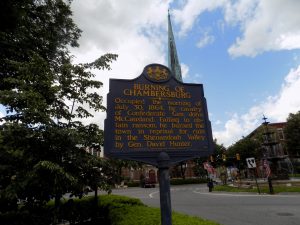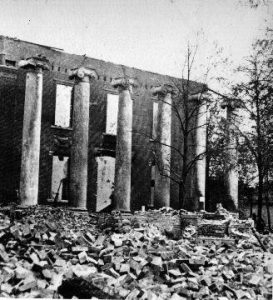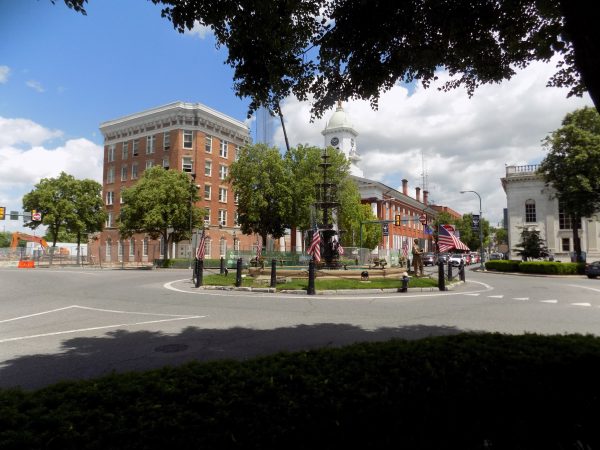ECW Weekender: A Quick Visit To Chambersburg, Pennsylvania

 Last May I drove country roads in four states in one day: Virginia, West Virginia, Maryland, and Pennsylvania. By early afternoon, I reached Chambersburg, Pennsylvania – one of my destinations. Parking my vehicle, I headed for the center of town and the local library.
Last May I drove country roads in four states in one day: Virginia, West Virginia, Maryland, and Pennsylvania. By early afternoon, I reached Chambersburg, Pennsylvania – one of my destinations. Parking my vehicle, I headed for the center of town and the local library.
Walking through the downtown district, I quickly realized that the Civil War history of the town stared me down: the lack of pre-Civil War era buildings. I love old historic towns and have been fortunate to walk with historians who’ve educated me on ways to guess/know the approximate age of buildings in the Middle Atlantic region. While the brick buildings in Chambersburg are beautiful, they are also a reminder of the destruction that occurred here at the end of July 1864.
On July 30, Confederates under General John McCausland arrived in town, sent by General Jubal Early. McCausland insisted on a ransom for the town and gave the residents a choice – $500,000 in United States currency or $100,000 in gold. The local bank had sent away its reserves and did not have those amounts on hand, but that didn’t matter to the Confederates.
Fires started, and about 500 structures of this county seat were destroyed, leaving approximately 2,000 people homeless. Homes of Republican politicians or abolitionists were particularly targeted, even if they were out of the path of conflagration.

Some Confederates protested the burning, others felt sorry for the civilians and helped them move their possessions as the flames got out of hand. When Colonel William Peters refused to follow McCausland’s orders, he was placed under arrest.
Some of the key buildings that survived the fire were the Masonic Temple and the Old Franklin County Jack. Confederate guarded the Masonic Temple and refused to let his comrades burn that building.
“Remember Chambersburg!” became a battle cry for some Union units in 1864. This burning incident marked the only time a Northern town was decisively destroyed during the Civil War. It also offered a justification for the harsher war approach and more civilian involvement during the coming months of 1864, particularly as the Union invaded the Shenandoah Valley for a final time.
I did not have time to fully explore Chambersburg, but if you are in town for just a quick visit be sure to see Memorial Square.
Here, you’ll see Old Franklin Country Jail (one of the survivor buildings) and post-Civil War buildings, including an impressive church.
In the center of the square, stands the Memorial Fountain which was dedicated in 1878. In front of the fountain stands a statue of a Civil War soldier; the ladies of Chambersburg started fundraising in 1868 to erect a memorial to the memory of Union soldiers. The fountain and memorial stand on the site of the 1861 “Liberty Pole” which stood 120 feet tall and flew a huge United States flag.

The Chambersburg Heritage Center on the square houses exhibits and Civil War artifacts.
For more details about what do see around or near the the square, check out this tour brochure!
Certainly, there’s lots of history to explore in Chambersburg, Pennsylvania, but if you only have an hour, head for the square and start there! You’ll be surrounded by history at every step and reminded of the burning by the post-1864 structures and architecture.
I also visited Chambersburg and really enjoyed this lovely town. Touring the old jail and visiting the house where John Brown lived while planning his raid were great. The exhibits in the Heritage Center are very interesting. I live in Frederick MD, which escaped burning by paying a ransom. Our local museum displays the ransom documents. I believe Frederick fought to get reimbursed by the federal govt until the 1950s.
I’m sure that, when Early approached Chambersburg, he remembered Union general David Hunter shelling and burning VMI the previous month. Hunter also burned the homes of several prominent Virginians. Here’s what John B. Gordon said in his memoirs. “General Hunter’s campaign of destruction did not end with the burning of the Virginia Military Institute. The homes of Governor Letcher (and several other prominent citizens) were burned with their entire contents; and only time enough was given the women and children to escape with their lives. Many other peaceful homes were burned under orders.”
I’m sure that, when Hunter’s troops moved up the Valley after Sigel’s repulse at New Market, they were none too pleased at the stories of how Valley civilians treated Union wounded poorly. Your book “Call The Cadets” points that out. But I’m also sure that, as Early’s men marched into Pennsylvania, many were ready to dish out some of what their families had just taken. For both sides, the war in the Valley had risen to a new,harsher level.